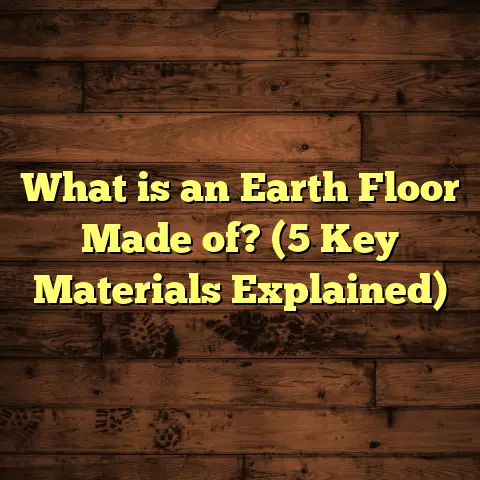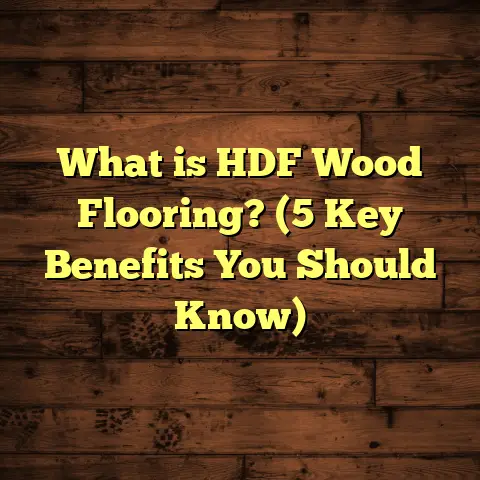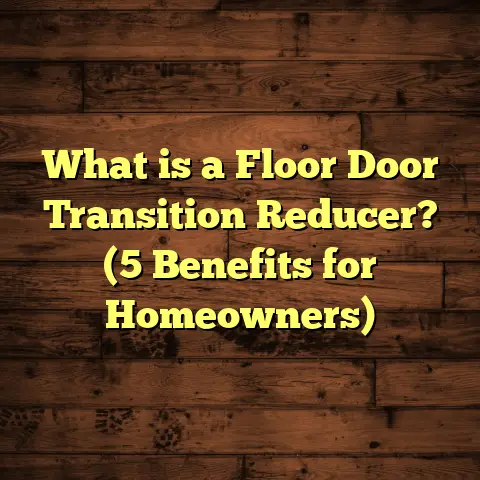What is Vinyl Flooring? (5 Key Benefits You Need to Know!)
When I think about flooring, I sometimes find myself going back to the very roots of human shelter. Imagine, thousands of years ago, early humans huddled in caves or simple huts, walking on floors made from packed earth, clay, or even animal skins. Flooring back then was all about function—keeping feet off the cold ground and providing some comfort. Fast forward to today, and flooring is a blend of function, style, and innovation.
One of the materials that has caught my attention over the years is vinyl flooring. It may not have the ancient history of stone or wood floors, but vinyl has an interesting story of its own. Invented in the 20th century, vinyl flooring has gone through many changes and improvements, becoming one of the most popular choices for modern homes and commercial spaces.
I’ve spent years installing and working with vinyl floors, and I want to share with you everything I’ve learned—the good, the not-so-good, and what makes vinyl such a standout option. So let’s start by answering a simple question:
What is Vinyl Flooring?
Vinyl flooring is a type of synthetic flooring made primarily from polyvinyl chloride (PVC) resin. It’s a man-made material designed to be tough, flexible, and water-resistant. The beauty of vinyl lies in its ability to imitate more expensive natural materials like hardwood, stone, or ceramic tile—yet it comes at a lower price point and offers some practical benefits that other materials can’t match.
Vinyl flooring comes in several forms:
- Sheet Vinyl: Large continuous rolls that are cut to fit the room. They offer a seamless surface and are often used in kitchens or bathrooms.
- Vinyl Tiles: Individual square tiles that can be arranged in patterns or layouts.
- Luxury Vinyl Planks (LVP): These mimic hardwood planks with realistic textures and colors. LVP is a favorite for its durability and authentic look.
Each type has its own installation method and best use cases, but they all share common traits—durability, water resistance, and affordability.
How Is Vinyl Flooring Made?
Understanding how vinyl flooring is made helps explain its qualities. Typically, vinyl flooring consists of several layers:
- Wear Layer: This is a clear protective coating on top that resists scratches, stains, and wear. The thickness of this layer varies by product quality.
- Design Layer: A printed film that gives the floor its appearance—wood grain, stone patterns, or any design imaginable.
- Core Layer: This provides stability and thickness. It can be flexible or rigid depending on the type.
- Backing Layer: This bottom layer supports the plank or tile and helps with adhesion during installation.
Higher-end luxury vinyl products tend to have thicker wear layers (ranging from 12 mil to 30 mil or more). This means better protection and longer life. Cheaper vinyl might have thinner wear layers and be less durable.
5 Key Benefits You Need to Know About Vinyl Flooring
Over the years, I’ve worked with many types of flooring—hardwood, laminate, tile—and vinyl certainly stands out for several reasons. Here’s what I consider the top five benefits you should know:
1. Durability That Handles Everyday Life
If you’re like me—or many of my clients—you want a floor that can take a beating. Kids running around, pets scratching at doors, heavy furniture being moved… those daily challenges can wreck some floors pretty fast.
Vinyl’s durability is one of its strongest selling points. The wear layer on modern vinyl protects against scratches, scuffs, stains, and even some impacts. I recall a client who had two large dogs; they were worried about paw scratches ruining their new floors. We installed luxury vinyl plank flooring with a 20 mil wear layer. After two years with active dogs running around daily, their floors still looked almost new.
Data backs this up: According to the Resilient Floor Covering Institute (RFCI), high-quality vinyl flooring can last 12–20 years in residential settings—sometimes longer if maintained well.
Even commercial spaces benefit from vinyl’s durability. Retail stores and offices with constant foot traffic often choose vinyl because it holds up well without needing frequent replacement.
2. Water Resistance for Peace of Mind
Have you ever spilled water on your hardwood floor and panicked? Or had a leaky dishwasher cause damage to your laminate? These nightmares are less likely with vinyl flooring because it offers excellent water resistance.
Sheet vinyl is typically fully waterproof because it comes in large continuous sheets without seams (or very few seams). Luxury vinyl planks are also highly water-resistant thanks to their core construction.
In one basement renovation I handled last year, the client wanted a floor that could survive humidity and occasional flooding. We chose waterproof LVP with an attached underlayment for comfort. Several months later, after heavy rain caused minor basement seepage elsewhere in the home, their floors were completely unaffected.
Manufacturers often market many vinyl products as waterproof or water-resistant, making them ideal for kitchens, bathrooms, basements, laundry rooms—anywhere moisture is a concern.
3. Affordability Without Sacrificing Style
When I first started working in flooring installation decades ago, genuine hardwood floors were out of reach for many budgets. Vinyl has changed that dynamic remarkably.
You can find vinyl flooring options ranging from very affordable sheet vinyl under $2 per square foot to luxury vinyl planks costing $4–$7 per square foot—still well below the price of hardwood or natural stone.
What surprises many people is how realistic modern vinyl looks. Thanks to high-resolution printing technology and texture embossing processes, LVP can mimic oak grain or marble veining almost perfectly.
A study by HomeAdvisor found that homeowners save an average of 40–60% on materials when choosing luxury vinyl plank instead of hardwood—without losing the aesthetic appeal.
4. Easier Installation Saves Time & Money
If you’ve ever seen a hardwood floor installed professionally, you know it requires skill and time—sometimes days or weeks depending on the space size.
Vinyl installation tends to be quicker and simpler. Sheet vinyl can be glued down or floated; luxury vinyl planks often use a click-lock system that snaps together like puzzle pieces. This reduces labor time dramatically.
In my experience managing multiple projects simultaneously, this ease of installation allows faster turnaround times and lower labor costs.
I once advised a client who wanted to DIY their kitchen floor. We selected peel-and-stick vinyl tiles that could be applied directly over existing floors after minor prep work. They finished the job in a weekend with great results.
5. Low Maintenance Means More Time Enjoying Your Home
Let’s face it: nobody wants to spend hours scrubbing floors or applying special treatments every month.
Vinyl flooring is incredibly low maintenance compared to hardwood or tile grout lines. Most spills wipe up easily; regular sweeping or vacuuming plus occasional damp mopping keeps it looking fresh.
I always recommend avoiding harsh chemicals or abrasive scrubbers as they can dull the wear layer over time.
Clients who choose vinyl often tell me how much they appreciate not having to wax or polish their floors regularly—a big win for busy families or commercial operators alike.
A Deeper Look: How Vinyl Stacks Up Against Other Flooring Types
To help you get a clearer picture, here’s how vinyl compares with some other popular flooring materials:
| Flooring Type | Cost per sq ft* | Water Resistance | Durability | Maintenance | Appearance Options |
|---|---|---|---|---|---|
| Luxury Vinyl Plank | $3 – $7 | Excellent | Very good | Low | Wood-look, stone-look |
| Hardwood | $6 – $12 | Poor | Good (susceptible to scratches) | Medium (refinishing needed) | Natural wood grains |
| Laminate | $2 – $5 | Moderate (some waterproof options) | Moderate | Medium | Wood-look |
| Ceramic Tile | $4 – $10 | Excellent | Excellent | Medium | Various patterns |
| Carpet | $3 – $8 | Poor | Moderate | High (requires cleaning) | Many colors & textures |
* Approximate prices vary by region and product quality
Vinyl shines when it comes to balancing cost with durability and water resistance—which explains why it’s so popular in kitchens, bathrooms, basements, and commercial spaces where moisture can be an issue.
My Favorite Vinyl Flooring Project Stories
Let me share some stories from my experience that highlight why I’m passionate about recommending vinyl flooring.
Story 1: The Busy Family Kitchen Makeover
A few years ago, I helped a family renovate their kitchen floor. They had small kids who frequently dropped food and spilled drinks—and a dog that tracked mud inside daily. Their old hardwood floor was scratched beyond repair.
We chose LVP with a 25 mil wear layer for top durability plus realistic oak wood design. The family was thrilled with how natural it looked but appreciated how easy it was to clean after spills.
Six months later at a follow-up visit, they told me how much less stressed they were about messes now—and how much their dog seemed to enjoy lying on the warm floor compared to cold tile previously installed nearby.
Story 2: The Basement Transformation
In another project, an older couple wanted to convert their dark basement into a cozy living space but worried about moisture issues.
We installed waterproof sheet vinyl with an underlayment that provided both comfort underfoot and added moisture barrier protection. The seamless nature of sheet vinyl helped prevent water from seeping underneath during rainy months.
They wrote me months later saying their basement felt warm and inviting—and they hadn’t experienced any mold or water damage problems since installation.
What Does Research Say About Vinyl Flooring?
Beyond my personal experiences, research confirms many benefits associated with vinyl flooring:
- A survey by the National Wood Flooring Association revealed that more than 35% of homeowners are choosing resilient flooring like vinyl due to its affordability and practical benefits.
- According to Consumer Reports testing in 2023, luxury vinyl plank outperformed laminate flooring in scratch resistance by 25% and water resistance by nearly 80%.
- The Environmental Protection Agency (EPA) highlights advances in low-VOC (volatile organic compounds) vinyl products that improve indoor air quality compared to earlier formulations.
- Case studies from commercial installations show that businesses reduce maintenance costs by up to 40% when switching from carpet or wood to durable vinyl floors.
These data points align closely with what I’ve observed working in different environments—from homes to offices and retail stores.
Helpful Tips Based on My Experience
Here’s some practical advice that will help you choose and maintain your vinyl floor wisely:
Choosing Vinyl Flooring
- Assess your lifestyle: Heavy foot traffic or pets? Go for thicker wear layers (20 mil or more).
- Check warranties: A longer warranty often indicates better manufacturing quality.
- Match your décor: Pick designs that complement your home’s style but remember texture matters as much as color.
- Installation preference: If you want a DIY project, peel-and-stick tiles or click-lock planks are easier than glue-down sheets.
- Look for certifications: Products certified by FloorScore or GREENGUARD have been tested for low emissions—better for health.
Installation Tips
- Always prepare your subfloor properly—clean it well and fix any uneven spots.
- For sheet vinyl, professional installation helps avoid bubbles or wrinkles.
- Use recommended adhesives if gluing down.
- Leave proper expansion gaps if using floating LVP systems.
- Acclimate planks in the room before installation for at least 48 hours.
Maintenance Tips
- Sweep or vacuum regularly to prevent grit buildup.
- Use pH-neutral cleaners designed for vinyl; avoid ammonia or bleach-based products.
- Wipe spills immediately.
- Protect high-wear areas with rugs or mats.
- Use furniture pads under heavy pieces to avoid dents.
Addressing Common Questions About Vinyl Flooring
I often get asked some common questions when discussing vinyl floors with clients:
Does vinyl flooring feel cold underfoot?
Compared to tile or stone, vinyl tends to feel warmer because it has some natural insulation properties. Adding an underlayment can increase comfort further.
Can I install vinyl over existing floors?
In many cases yes—as long as the existing floor is clean, dry, flat, and secure. This can save time and money during renovations.
Is vinyl eco-friendly?
Vinyl is made from PVC which isn’t biodegradable but many manufacturers now produce low-VOC products and recycle scrap material during production. Look for brands with sustainability certifications if this matters to you.
How do I repair damaged vinyl flooring?
Small scratches may buff out with special cleaners; deeper gouges often require replacing individual tiles or planks if possible. Sheet vinyl repairs are trickier but patch kits exist.
Wrapping Up My Thoughts on Vinyl Flooring
After years of working hands-on with different types of floors across homes and businesses, vinyl remains one of my top recommendations for its mix of practicality, aesthetic appeal, affordability, and ease of maintenance.
Whether you want something tough enough for kids and pets, waterproof for wet areas, or budget-friendly without looking cheap, vinyl checks those boxes nicely.
If you’re thinking about updating your floors soon, consider exploring luxury vinyl plank or sheet options. Talk with your local flooring expert to pick the right product suited specifically for your space and lifestyle needs.
And if you want advice on installation methods, maintenance tricks, or product recommendations, don’t hesitate to reach out—I’m always happy to share what I’ve learned over the years to help make your flooring project smooth and successful!




